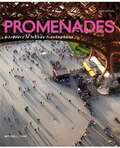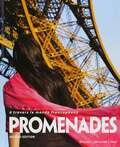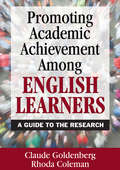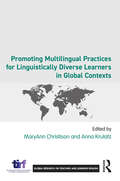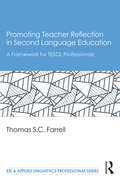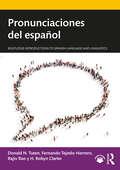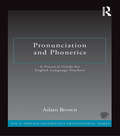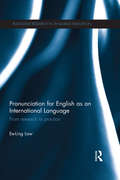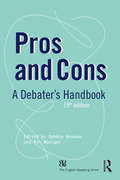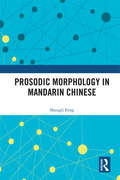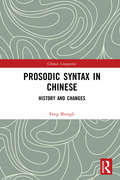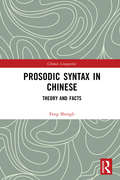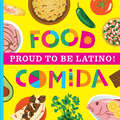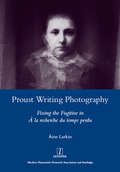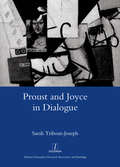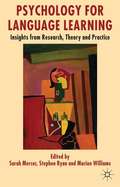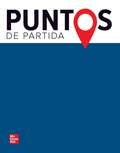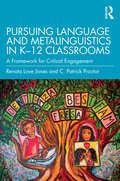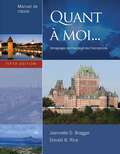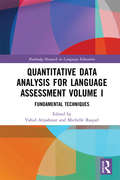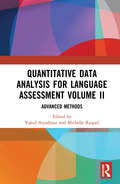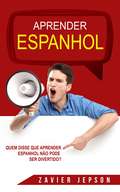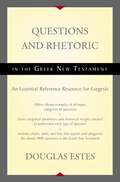- Table View
- List View
Promenades: A Travers Le Monde Francophone
by James G. MitchellWelcome to PROMENADES, Third Edition, a unique introductory French program from Vista Higher Learning. In French, the word promenades means strolls. The major strands in PROMENADES, Second Edition, are strolls planned to help you learn French and explore the cultures of the French-speaking world in the most user-friendly way possible. In light of this goal, here are some of the features you will encounter in PROMENADES, Third Edition.
Promenades: A Travers le Monde Francophone
by Cherie Mitschke Cheryl Tano James G. MitchellWelcome to PROMENADES, Second Edition, a unique introductory French program from Vista Higher Learning. In French, the word promenades means strolls. The major strands in PROMENADES, Second Edition, are strolls planned to help you learn French and explore the cultures of the French-speaking world in the most user-friendly way possible. In light of this goal, here are some of the fea¬tures you will encounter in PROMENADES, Second Edition.
Promenades: À travers le monde francophone
by Cherie Mitschke Cheryl TanoPromenades, 2nd Edition, focuses on building those skills introductory students need to feel confident while immersing themselves in authentic French culture.
Promoting Academic Achievement Among English Learners: A Guide to the Research
by Claude Goldenberg Rhoda ColemanDiscover the research and facts on what works in educating English learners! This comprehensive resource examines the research on promoting success among students who come to school knowing little or no English and translates current findings into specific recommendations for developing policies and programs for English learners. With illustrative scenarios throughout, this book gives educators and policy makers solid, research-based information about: Using students’ home language in academic programming Teaching English and academic content simultaneously School and district factors that affect achievement for English learners Sociocultural factors in success, including the influence of parents and families
Promoting Multilingual Practices for Linguistically Diverse Learners in Global Contexts (Global Research on Teaching and Learning English)
by Anna KrulatzThe eleventh volume in the Routledge-TIRF series presents research on multilingualism in educational contexts across the globe. With chapters written by TIRF Doctoral Dissertation Grant awardees and internationally known scholars, the volume addresses the challenges and pedagogies associated with moving away from the monolingual paradigm to support the development of culturally and linguistically diverse learners. Offering original research, new models, and pedagogies on teaching from over 17 different countries, this volume familiarizes readers with the latest advances in theory and practice and is a key text for language education programs and pre-service teachers.
Promoting Teacher Reflection in Second Language Education: A Framework for TESOL Professionals (ESL & Applied Linguistics Professional Series)
by Thomas S. FarrellTaking the concept and the practice of reflective teaching forward, this book introduces a well-structured, flexible framework for use by teachers at all levels of development, from pre-service to novice to the most experienced. The framework outlines five levels of reflective practice—Philosophy; Principles; Theory-of-Practice; Practice; Beyond Practice—and provides specific techniques for teachers to implement each level of reflection in their work. Designed to allow readers to take either a deductive approach, moving from theory-into-practice, or an inductive approach where they start from a practice-into-theory position, the framework can be used by teachers alone, in pairs, or in a group.
Pronunciaciones del español
by Rajiv Rao Fernando Tejedo-Herrero Donald N. Tuten H. Robyn ClarkePronunciaciones del español es una introducción accesible a la fonética y la fonología del español que destaca la diversidad de pronunciaciones empleadas en el mundo hispanohablante. Con explicaciones claras y gráficos detallados, este libro guía al estudiante en el aprendizaje de conceptos claves de fonética articulatoria y acústica. El libro presta especial atención a la variación sociolingüística, a partir de ejemplos que cubren pronunciaciones típicas de variedades estándares y de variedades generalmente consideradas no normativas. Una abundante selección de ejercicios y actividades permite al estudiante reforzar la comprensión de conceptos claves y practicar las pronunciaciones comentadas. Un glosario bilingüe (español-inglés), archivos de audio y recursos pedagógicos se encuentran disponibles en línea en www.routledge.com/9781138657540. El libro es idóneo para estudiantes que inician estudios al nivel avanzado de español y de lingüística hispánica y que buscan familiarizarse con las pronunciaciones de diferentes variedades de español. Pronunciaciones del español is an accessible introduction to the linguistic diversity of Spanish phonetics and phonology. With clear explanations and detailed illustrations, this book guides students through key concepts in articulatory and acoustic phonetics. Particular attention is paid throughout to sociolinguistic variation, with examples covering pronunciations typical of standard varieties as well as varieties generally considered to be non-normative. A rich array of exercises and activities allow students to reinforce understanding of key concepts and practice the pronunciations as described. A bilingual glossary, accompanying audio files and teaching resources are available online at www.routledge.com/9781138657540. This book is ideal for advanced students of Spanish and Hispanic Linguistics, looking to develop familiarity with the pronunciation of different varieties of Spanish.
Pronunciation and Phonetics: A Practical Guide for English Language Teachers (ESL & Applied Linguistics Professional Series)
by Adam BrownThis engaging, succinct text is an introduction to both phonetics and phonology as applied to the teaching of pronunciation to English language learners. Section 1 selectively covers the main areas of phonetics and phonology, without going into any area in more depth than the average English language teacher requires or that the average English language teacher trainee can handle. Section 2 focuses on practical issues related to learners and how they learn languages, and what represents good practice in terms of classroom activities for pronunciation—including aspects such as targets, motivation and priorities. The chapters end with activities to help the reader understand concepts. Section 3 provides innovative sample activities which put into practice the theoretical points covered in the first two sections, answers to the various exercises, recommended further reading (both print and non-print), a glossary of technical phonetic terms, and a bibliography of works on pronunciation teaching. The text is accompanied by a Companion Website with audio recordings of model pronunciations and audio material relating to the activities.
Pronunciation for English as an International Language: From research to practice (Routledge Research in Language Education)
by Ee-Ling LowPronunciation plays a crucial role in learning English as an international language, yet often remains marginalised by educators due to a lack of required phonetic and phonological knowledge. Pronunciation for English as an International Language bridges the gap between phonetics, phonology and pronunciation and provides the reader with a research based guide on how best to teach the English language. The book follows an easy to follow format which ensures the reader will have a comprehensive grasp of each given topic by the end of the chapter. Key ideas explored include: • Articulation of English speech sounds and basic transcription • Connected speech processes • Current issues in English language pronunciation teaching • Multimedia in English language pronunciation practice • Using speech analysis to investigate pronunciation features Using the latest research, Pronunciation for English as an International Language will facilitate effective teaching and learning for any individual involved in teaching English as a second, foreign or international language.
Pros and Cons: A Debaters Handbook
by Debbie Newman Ben WoolgarPros and Cons: A Debaters Handbook offers a unique and invaluable guide to the arguments both for and against over 140 current controversies and global issues. Since it was first published in 1896 the handbook has been regularly updated and this nineteenth edition includes new entries on topics such as the right to possess nuclear weapons, the bailing out of failing industries, the protection of indigenous languages and the torture of suspected terrorists. <P><P> Equal coverage is given to both sides of each debate in a dual column format which allows for easy comparison. Each entry also includes a list of related topics and suggestions for possible motions. <P><P> The introductory essay describes debating technique, covering the rules, structure and type of debate, and offering tips on how to become a successful speaker. The book is then divided into eight thematic sections, where specific subjects are covered individually.
Prosodic Morphology in Mandarin Chinese
by Shengli FengIt is not entirely clear if modern Chinese is a monosyllabic or disyllabic language. Although a disyllabic prosodic unit of some sort has long been considered by many to be at play in Chinese grammar, the intuition is not always rigidly fleshed out theoretically in the area of Chinese morphology. In this book, Shengli Feng applies the theoretical model of prosodic morphology to Chinese morphology to provide the theoretical clarity regarding how and why Mandarin Chinese words are structured in a particular way. All of the facts generated by the system of prosodic morphology in Chinese provide new perspectives for linguistic theory, as well as insights for teaching Chinese and studying of Chinese poetic prosody.
Prosodic Syntax in Chinese: History and Changes (Chinese Linguistics)
by Feng ShengliIn the two volumes of Prosodic Syntax in Chinese, the author develops a new model, which proposes that the interaction between syntax and prosody is bi-directional and that prosody can not only constrains syntactic structures but also activates syntactic operations. All of the facts investigated in Chinese provide new perspectives for linguistic theories as well as the insights into the nature of human languages. The subtitles of the two volumes are Theory and Facts and History and Change respectively, with each focusing on different topics (though each volume has both theoretical and historical descriptive concerns). In this volume, the author first introduces the relevant theories and concepts of Metrical Phonology, Prosodic Phonology and Formal Syntax, and formulates the Government-based Nuclear Stress Rule in Chinese which can explain how and why Mandarin Chinese sentences are structured in a particular way. It is proposed that prosody can not only blocks the legitimate syntactic structures but also activates the potential syntactic operations. The former can be seen from the ungrammatical sentences that are caused by the inoperable NSR in these structures while the latter can be seen from sentences that are derived from syntactic movements which, however, are operable only when being motivated by prosody.
Prosodic Syntax in Chinese: Theory and Facts (Chinese Linguistics)
by Feng ShengliIn the two volumes of Prosodic Syntax in Chinese, the author develops a new model, which proposes that the interaction between syntax and prosody is bi-directional and that prosody not only constrains syntactic structures but also activates syntactic operations. All of the facts investigated in Chinese provide new perspectives for linguistic theories as well as insights into the nature of human languages. The subtitles of the two volumes are Theory and Facts and History and Change respectively, with each focusing on different topics (though each volume has both theoretical and historical descriptive concerns). This book has shown that prosody has played a crucial role in triggering the many changes in the diachronic development of Chinese. On the one hand, this book investigates the existence of SOV structures in Early Archaic Chinese, a SVO language, and then demonstrates the role of VO prosody in causing the disappearance of the remnant structures after the Han Dynasty. On the other hand, this book surveys the historical evidence for analyses of bei passives and Ba-constructions, and then offers a prosodic analysis on the origin of these two sentence patterns in Chinese. It is claimed that prosody can be an important factor in triggering, balancing and finally terminating changes in the syntactic evolution of Chinese.
Proud to Be Latino: Food/comida
by Ashley Marie MirelesDid you know that there are over 5000 types of potatoes sold in South America? Or that in Honduras, a song about conch soup reached the Billboard Top 100 Charts? Latino culture spans Southern and Central America as well as the Caribbean, but often when we think of Latino foods, we think tacos, burritos, and other common Mexican dishes. Proud to Be Latino: Food/Comida teaches children how different Latino countries use similar ingredients to create unique regional dishes.The dishes and their descriptions are given in both English and Spanish, and parents will enjoy the sidebars with additional fun facts about Latino food and culture. This bilingual board book takes the reader beyond a basic language primer and dives deep into the heart of Latino culture . . . which is the food, of course!
Proust Writing Photography: Fixing the Fugitive in A La Recherche Du Temps Perdu
by Aine LarkinThe importance of vision and visual arts such as painting, theatre, and sculpture in Marcel Proust's A la recherche du temps perdu has long been affirmed; another significant system of visual representation in the novel is photography. Proust appropriated photography as a practice with its own distinctive characteristics which could inform his writing about the processes of perception and memory. Through close textual analysis of scenes where photography is experienced or observed as a practice, and scenes where photography is written into the body of the text, Aine Larkin offers an invigorating new study that sheds genuinely new light on the presence of photographic motifs in Proust's novel, and the subtlety of Proust's engagement with this modern imaging system in his work.
Proust and Joyce in Dialogue
by Sarah Tribout-JosephIt might reasonably be asked what the connection is between Francoises malapropisms in Proust and the erudite allusions of Stephens interior monologue in Joyce. Tribout-Joseph argues that they are indeed interrelated. Proust and Joyce are exemplary of Modernisms reconciliation of high literature with popular voices. Both writers explore the process of incorporation, the interface between speech and narrative. Fragments of discourse are taken from diverse sources and reoriented within new contexts. Proposed here are interconnected close readings of socio-political debate, body talk, listening processes, silences, intertextual echoes, cliche, register, conflated voices, chatter, gossip, eavesdropping, internalized debate, and misunderstandings which allow for a new configuration of the authors to emerge.
Psychology for Language Learning
by Marion Williams Sarah Mercer Stephen RyanOffering a timely snapshot of current theory and research in the field of psychology in foreign language learning, this book is accessible to both specialists and non-specialists. Each chapter focuses on a different psychological construct and provides an overview of current thinking in the area drawing on insights from educational psychology.
Puntos de Partida
by Thalia DorwickSuccess in the language classroom requires so much more than just a text. In any language-learning setting, students require numerous and various opportunities to read, write, hear, and speak. <p><p> Puntos de partida sets the standard for Spanish-language teaching. An innovative program that has been continuously refined for today’s class, Puntos delivers proven pedagogy with clear and effective presentations, comprehensive teaching resources, and powerful digital tools. <p><p> Now in its eleventh edition, Puntos continues to build on the holistic, five-skills approach it pioneered, and offer a wealth of resources for every instructor and every learner. <p><p> Puntos hallmark features include: <p><p> A comprehensive scope and sequence that allows instructors to choose what to cover throughout the course without having to supplement their own materials to fill gaps present in other texts. <p><p> A carefully arranged organization that progresses from formulaic expressions to vocabulary and grammar relevant to daily life and personal interests (studies, family, home, leisure activities), then goes on to prepare students for survival situations (ordering a meal, traveling), and finally branches out to broader themes (current events, social and environment issues). This forward progress is reinforced by a cyclical structure where vocabulary, grammar, and language functions are continuously reviewed and recycled. <p><p> Clear and effective vocabulary and grammar presentations that focus on the acquisition of vocabulary during the early stages of language learning and then at the start of each chapter throughout the text. Grammar is introduced in thorough explanations, with careful attention given to skills development rather than grammatical knowledge alone. <p><p> An integrated five-skills approach: One of the defining features of Puntos is its careful sequencing of activities, moving students from controlled to free-form tasks. Building off of the improved scaffolding in the tenth edition, the eleventh edition includes Proyectos, engaging communication tasks positioned at key moments in each chapter that guide students to create in the target language and accomplish a culturally significant goal. <p><p> Engaging and Immersive Digital Tools: McGraw-Hill’s Connect course management system is rooted in research on effective student learning practices, integrating adaptive learning tools with dynamic, engaging language practice activities. McGraw-Hill’s LearnSmart provides each student with a personalized and adaptive learning experience based on individual needs. Practice Spanish: Study Abroad, the market’s first 3-D immersive language game, brings the Spanish language to students in a fun, engaging experience. Students study abroad virtually in Colombia where they create their own avatar, live with a host family, make new friends, and navigate a variety of real-world scenarios using their quickly developing language skills. Recordable Video Chat powered by GoReact, is a chat tool, now available on Connect, that allows students to practice live, synchronous communication. Voice Board, by GoReact, is a new asynchronous voice tool that gives students the chance to post video, audio, or text comments related to the topic and respond to their classmates’ posts.
Pursuing Language and Metalinguistics in K–12 Classrooms: A Framework for Critical Engagement
by C. Patrick Proctor Renata Love JonesThis conceptually expansive volume provides a theoretical framework and practical guide for designing and implementing literacy instruction that promotes students’ critical metalinguistic awareness in K–12 classroom contexts.Grounded in varied instructional contexts, the chapters present theories of language and overviews of research in ways that are accessible and engaging. Through innovative research and practical examples, the authors show how educators can address content areas, modalities, and K–12 student populations in increasingly diverse classroom spaces.Concrete instructional examples throughout, along with a culminating set of teacher vignettes, make this text an invaluable resource for pre-service teachers, graduate students, and scholars in the field of literacy education.
Quant a moi
by Jeannette D. Bragger Donald B. RiceStructured for student success and organized for instructional flexibility, QUANT A MOI...: TÉMOIGNAGES DES FRANÇAIS ET DES FRANCOPHONES, 5th Edition is written for intermediate courses that emphasize meaningful in-class communication and in-depth exploration of Francophone cultures. Thoroughly updated, the Fifth Edition offers an easy-to-follow structure that facilitates lesson planning and ease of progression through each chapter. The accompanying MANUEL DE PRÉPARATION offers independent grammar review and practice, allowing class time to be devoted to the culturally rich communicative activities found in the student textbook, MANUEL DE CLASSE. The new edition includes engaging new cultural readings.
Quantitative Data Analysis for Language Assessment Volume I: Fundamental Techniques (Routledge Research in Language Education)
by Vahid Aryadoust Michelle RaquelQuantitative Data Analysis for Language Assessment Volume I: Fundamental Techniques is a resource book that presents the most fundamental techniques of quantitative data analysis in the field of language assessment. Each chapter provides an accessible explanation of the selected technique, a review of language assessment studies that have used the technique, and finally, an example of an authentic study that uses the technique. Readers also get a taste of how to apply each technique through the help of supplementary online resources that include sample data sets and guided instructions. Language assessment students, test designers, and researchers should find this a unique reference as it consolidates theory and application of quantitative data analysis in language assessment.
Quantitative Data Analysis for Language Assessment Volume II: Advanced Methods
by Vahid Aryadoust Michelle RaquelQuantitative Data Analysis for Language Assessment Volume II: Advanced Methods emonstrates advanced quantitative techniques for language assessment. The volume takes an interdisciplinary approach and taps into expertise from language assessment, data mining, and psychometrics. The techniques covered include Structural Equation Modeling, Data Mining, Multidimensional Psychometrics and Multilevel Data Analysis.Volume II is distinct among available books in language assessment, as it engages the readers in both theory and application of the methods and introduces relevant techniques for theory construction and validation. This book is highly recommended to graduate students and researchers who are searching for innovative and rigorous approaches and methods to achieve excellence in their dissertations and research. It is also a valuable source for academics who teach quantitative approaches in language assessment and data analysis courses.
Quem Disse Que Aprender Espanhol Não Pode Ser Divertido?
by Zavier Jepson Miguel Matos>> Compre a Edição em Papel Deste Livro e Ganhe a Versão Kindle de GRAÇA Você está procurando dar uma melhorada no seu espanhol? Quer aprender o idioma o mais rápido possível para o próximo feriado ou reunião familiar? Então você veio ao lugar certo! Quem Disse Que Aprender Espanhol Não Pode Ser Divertido? te tornará fluente rapidinho, com um método de aprendizado mais rápido que te fará dominar o espanhol em apenas 3 dias! Neste livro você aprenderá: • Técnicas Para o Aprendizado de Idiomas • Pronúncias Corretas, Verbos e Frases Básicas Para Conversas do Dia a Dia em Espanhol • Construção de Uma Rotina de Aprendizado em Espanhol • Super Aula de 3 Dias!!! • Guia Estendido de 30 Dias Para Falar Espanhol • ... E muito, muito mais! Não espere mais! Desça a Página e Clique Em Comprar Para Adquirir Este Livro HOJE. Comece a Melhorar Seu Espanhol Agora!
Questions and Rhetoric in the Greek New Testament: An Essential Reference Resource for Exegesis
by Douglas EstesWhile there are almost 1000 questions in the Greek New Testament, many commentators, pastors, and students skip over the questions for more ‘theological’ verses or worse they convert questions into statements to mine them for what they are saying theologically. However, this is not the way questions in the Greek New Testament work, and it overlooks the rhetorical importance of questions and how they were used in the ancient world. Questions and Rhetoric in the Greek New Testament is a helpful and thorough examination of questions in the Greek New Testament, seen from the standpoint of grammatical, semantic, and linguistic analysis, with special emphasis on their rhetorical effects. It includes charts, tools, and lists that explain and categorize the almost 1000 questions in the Greek New Testament. Thus, the user is able to go to the section in the book dealing with the type of question they are studying and find the exegetical parameters needed to understand that question. Questions and Rhetoric in the Greek New Testament offers vibrant examples of all the major categories of questions to aid the reader in grasping how questions work in the Greek New Testament. Special emphasis is given to the way questions persuade and influence readers of the Greek New Testament.
